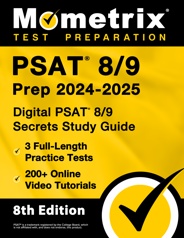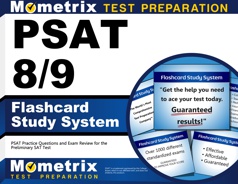Every year, thousands of high school students across the country prepare for the SAT. But before they take the SAT, students prepare throughout their high school years by taking the Preliminary SAT (PSAT).
While it is not required, it is highly recommended that you take the PSAT to familiarize yourself with standardized testing.
This page focuses on the PSAT 8/9, which is designed specifically for eighth- and ninth-graders.
What is the PSAT 8/9?
The Preliminary Scholastic Aptitude Test (PSAT) 8/9 is administered by the College Board, the organization that helps high school students prepare for college through programs and services such as the SAT Suite of Assessments and the Advanced Placement (AP) Program.
The PSAT 8/9, along with all the other aptitude tests the College Board offers, is designed to measure the knowledge and skills you learn from school that will be beneficial to help you through college and your career. Your reading, writing, and math skills will be assessed through questions that are grade-appropriate for eighth and ninth graders.
The PSAT 8/9 score report also includes a section called AP Potential. This lets you know which AP courses you may be ready to take based on your PSAT assessment.
Check Out Mometrix's PSAT 8/9 Study Guide
Get practice questions, video tutorials, and detailed study lessons
Get Your Study Guide
PSAT 8/9 Exam Outline
The PSAT 8/9 consists of two tests: the Reading and Writing test and the Math test. The exam has a total of 98 items and the time allotted is 2 hours and 14 minutes. Most of the items in the exam are presented in multiple-choice format, but some math questions may ask you to write in the answer rather than select it from a list of choices.
Reading
The Reading test contains 54 questions, which are divided into two modules, and you will be given 64 minutes to complete the section. Each question in this section consists of reading a passage and answering a related multiple-choice question. Some questions demand information recall, but most require you to use inference skills and context clues to determine the best answer choice.
The passages range from 500-750 words and are usually from a US founding document, a piece of literary fiction, or a globally relevant work. There are also two passages on either the social sciences or the natural sciences.
This section will evaluate your skills in the following four categories:
- Craft and Structure: This category focuses on your ability to analyze, comprehend, and synthesize text, as well as your reasoning skills and vocabulary knowledge.
- Information and Ideas: This category focuses on your ability to evaluate central details and ideas, make inferences, and wield evidence found in tables, graphs, and texts.
- Standard English Conventions: This category focuses on your text editing skills. Specifically, you will be tested on your knowledge of English sentence structure, usage, and punctuation.
- Expression of Ideas: This category focuses on your ability to revise and improve the effectiveness of a text.
Math
The Math test contains 44 questions, which are divided into two modules, and you will be given a time limit of 70 minutes. You will be able to use a calculator throughout the entire Math section, whether it’s the provided digital calculator or an approved physical calculator.
The questions are grouped into four domains.
- Algebra: This domain focuses on the mastery of linear equations, systems of linear equations, and functions. These questions will evaluate your ability to represent situations through equations and solve them, as well as make connections between different representations of linear relationships.
- Advanced Math: This domain focuses on your skills and abilities regarding absolute value, equivalent expressions, and nonlinear functions.
- Problem Solving and Data Analysis: This domain focuses on analyzing problems and drawing information from data. These questions include using ratios, percentages, and statistical analysis to assess a practical command of math applied to real-world situations.
- Geometry and Trigonometry: This domain focuses on your ability to solve geometric problems. You will be tested on your knowledge of area, volume, circles, right triangles, and lines.
How to Register
You may take this test on a regular school day between the months of September and April. Your high school will most likely arrange for scheduled testing dates during these months or you may also inquire with your school guidance counselor regarding this matter. The fee for the test materials used is $14, but your high school may also decide to cover these expenses for the students.
Homeschooled students can request to take the test by contacting their local school. For students with disabilities and special testing accommodations, official approval is not needed by the College Board. Students outside the US who want to take the PSAT 8/9 must contact a local school in their current country at least four months before the exam for ample preparation.
Test Day
What to Bring On Test Day
There are only a couple of things that are necessary on the day of the test. The most important things to bring are two No. 2 pencils, an eraser, an approved calculator, and a face covering. Specific medications such as epinephrine auto-injectors are allowed as long as they are placed in a clear bag.
In addition to these items, students outside the US should be prepared with their US school’s code, their US school’s name and address, and the name and address of the school where they’re taking the test.
What NOT to Bring On Test Day
The College Board lists the following as items that you are not allowed to bring with you into the testing room:
- Mobile phones, smartwatches, fitness trackers, or other wearable technology
- Audio players or recorders, tablets, laptops, notebooks, Bluetooth devices, or any other personal computing devices
- Separate timers of any type
- Cameras or any other photographic equipment
- Pens, highlighters, or mechanical or colored pencils
- Books or references of any kind
- Compasses, rulers, protractors, or cutting devices
- Papers of any kind, including scratch paper
- Earplugs
- Calculators that have QWERTY keyboards, use paper tape, make noise, or use a power cord
- Weapons or firearms
Check Out Mometrix's PSAT 8/9 Flashcards
Get complex subjects broken down into easily understandable concepts
Get Your Flashcards
Scores
Scoring for the PSAT 8/9 starts with your raw score for the exam where a correct answer is equivalent to one point, and a wrong answer or blank question equals no point. The raw score is then converted into a scaled score from a specific range.
Your overall score report will show a number in the range of 240-1440. This is your total score for the PSAT 8/9. You will also see your score percentile. This is the percentage of eighth or ninth graders who scored higher or lower than you after taking the test during the same time period.
This overall score is composed of two section scores: your Evidence-Based Reading and Writing score (composed of the Reading and Writing and Language Tests), and your Math score (composed of the No-Calculator and Calculator Tests).
Your score will be in the range of 120-720 along with its corresponding percentile. Aside from that, your score report will also show your specific test scores, cross-test scores, and sub-scores to get an in-depth look at your academic performance.
Scoring Benchmarks
While there is no strict passing or failing score, College Board sets benchmarks to gauge your readiness for college and career training programs:
For eighth-graders: 390 for Evidence-Based Reading and Writing, and 430 for Math
For ninth-graders: 410 for Evidence-Based Reading and Writing, and 450 for Math
Since all College Board aptitude tests use the same scale, it is generally expected that the score and percentile you get in the PSAT 8/9 will be similar to what you will get after taking the PSAT 10, PSAT/NMSQT, and SAT. This may be a good thing to keep in mind when viewing your score report.
Receiving Score Results
Scores are released depending on when the exam was administered. Generally, scores will take any time from three to six weeks to process, after which your teachers will receive the scores. Students then receive their score reports online a week later.
For students 13 years old and above, you may view your score report by logging into your College Board account on their website. Otherwise, the school may either print out your score report or email it to you or your parents individually.
PSAT 8/9 Online Prep Course
If you want to be fully prepared, Mometrix offers an online PSAT 8/9 prep course designed to give you everything you need to succeed!
Here’s what you’ll find in the PSAT 8/9 course:
- 70+ Review Lessons Covering Every Topic
- Over 850 PSAT 8/9 Practice Questions
- 250+ Video Tutorials
- 450+ Digital Flashcards
- Money-back Guarantee
- Mobile Access
Everyone learns differently, so we’ve tailored the PSAT 8/9 online prep course to ensure every learner has what they need to prepare for the PSAT 8/9 exam.
Click below to check it out!
Preparing for the Test
The PSAT 8/9 is specifically designed to identify the subject areas that students should focus on and set a starting point for progress. To ensure students are prepared, we have designed our Mometrix study materials to provide students with everything they need to review these specific subject areas.
Click the buttons below to check out our PSAT 8/9 printed study guide, which contains PSAT 8/9 practice questions, and our set of flashcards!
FAQs
Q
What math is on the PSAT 8/9?
A
The Math test focuses on the main areas of math that are most relevant in a wide range of college majors and careers: algebra, problem solving, data analysis, geometry, and trigonometry. Click here for more information about the math portion of the PSAT 8/9.
Q
How long is the PSAT 8/9?
A
The time limit for the PSAT 8/9 is 134 minutes.
Q
What is a passing score on the PSAT 8/9?
A
There is no strict passing score on the PSAT 8/9. The benchmarks to gauge readiness for college and career training programs are as follows:
For ninth-graders: 410 for Evidence-Based Reading and Writing, and 450 for Math
Q
Can I retake the PSAT 8/9?
A
Regulations from the College Board state that no student can take the PSAT 8/9 more than once per academic school year.
PSAT/NMSQT® is a trademark registered by the College Board and the National Merit Scholarship Corporation, which are not affiliated with and do not endorse this content.



